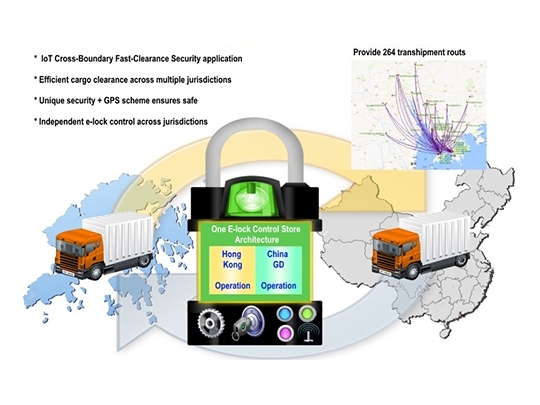IoT System Case Study: Cross-Boundary Fast Clearance Security System
Since November 2012, LSCM has assisted Hong Kong Customs with the trial of the “Single E-lock Scheme” with Mainland Customs. We set out to connect Hong Kong Customs’ Intermodal Transshipment Facilitation Scheme (ITFS) with the Speedy Customs Clearance (SCC) system used by Mainland Customs. Under this scheme, the processing time for customs clearance of registered trucks at land boundary control points can be reduced by up to two hours.
Until now, the scheme has been extended to 63 clearance points in Guangdong province including Guangzhou Nansha Free Trade Zone, Jiangmen International Electronic Commerce Express Mail Sorting Clearance Centre and Guangzhou Airport. The scheme also goes through 13 clearance points in Hong Kong, including the Hong Kong International Terminals and Kwai Chung Customhouse, and 819 express intermodal transportation routes are offered. Up until May 2019, the scheme has been on trial more than 118,900 times, with over 52 million consignments being handled. Since the official launching of the “Single E-Lock Scheme” in late March of 2016 by both Customs authorities, the IoT Cross Boundary Fast-Clearance system developed by LSCM streamlines customs clearance processes. This renders customs clearance between Hong Kong and Guangdong more convenient, efficient, and most importantly - secure.
The continuous increase of clearance points under the Scheme in Guangdong Province will further expedite cargo flow between Hong Kong and the Mainland and strengthen Hong Kong's position as an international trading and logistics hub. Different types of enterprises are encouraged to make full use of the Scheme and the expanded clearance point network to capitalise on business opportunities brought about by developments in the Greater Bay Area.
E-Lock Technology for IoT Systems in Hong Kong
LSCM is proud to have facilitated the development of E-Lock technology for the betterment of the IoT system in Hong Kong.
This innovative E-Lock technology is developed to support multiple control processes to ensure secured operation across different customs controls. The use of asymmetric keys ensures the operation security of the activation and deactivation of the E-Lock device.
Easy to operate and highly effective, this technology has improved security and efficiency across the sector’s operations. The E-Lock has won the silver medal at the 45th Geneva International Exhibition of Inventions held from 29 March to 2 April 2017.
If you have any questions about how LSCM promotes innovation across multiple industries, feel free to contact us.
IoT, or the Internet of Things, refers to a network of physical devices that are interconnected and capable of exchanging data with each other over the Internet without requiring human intervention. These devices, often referred to as "smart" devices, can range from everyday objects like household appliances and wearable devices to industrial mechanical systems and infrastructure components.
Imagine a world where objects around us, such as thermostats, refrigerators, and even streetlights, are connected to the internet and can communicate with each other. These devices have sensors or embedded technology that allows them to collect and transmit data. For example, a smart thermostat can monitor temperature and adjust itself accordingly, while a wearable fitness tracker can measure your heart rate and track your physical activity.
How do IoT systems work?
At the core of an IoT system are the devices. These can be everyday objects, such as thermostats, lights, or even vehicles, that are equipped with sensors or small computers. These sensors collect information from their surroundings, such as temperature, humidity, or motion.
The collected data is then processed by the device itself or sent to a central hub called a gateway. The gateway acts as a bridge between the devices and the internet. It receives the data from multiple devices and sends it to the next stage.
Next, the data travels through the internet to cloud servers. Cloud servers are powerful computers that store and analyze data from various sources. They process the data, extract meaningful insights, and trigger appropriate actions based on predefined rules or algorithms. Once the data is analysed, it can be accessed and utilised by users through applications or interfaces. For example, you can control your smart home devices using a smartphone app or receive alerts about unusual events.
The communication between the devices, gateway, cloud servers, and user interfaces happens through various networks, such as Wi-Fi, cellular networks, or Bluetooth. These networks enable the devices to connect to the internet and transmit data securely.
In simpler terms, IoT systems work by connecting devices to the internet, collecting data from their surroundings, sending that data to a central processing hub, analyzing it, and providing useful information or triggering actions based on the analysis.










